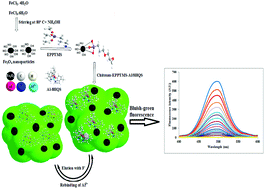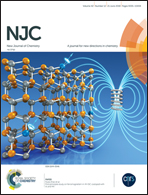Synthesis of Fe3O4 nanobead-functionalized 8-hydroxyquinoline sulfonic acid supported by an ion-imprinted biopolymer as a recognition site for Al3+ ions: estimation in human serum and water samples†
Abstract
Herein, a novel “turn on” ion-imprinted chemosensor for highly sensitive and selective detection of Al3+ ions in complex matrices has been developed. The method was based on using chitosan (CHIT) biopolymer/magnetite nanoparticles (MGNPs) functionalized with 8-hydroxyquinoline sulfonic acid (8-HQS) in the presence of Al3+ ions to synthesize a magnetite ion non-imprinted biopolymer (MGINIBP) chemosensor. This newly developed chemosensor was synthesized via polymerization of CHIT with [3-(2,3-epoxypropoxy)-propyl]trimethoxysilane [EPPTMS] in the presence of magnetite nanoparticles, 8-HQS, and an Al3+ ion template. The template was then removed from the sensor using 0.5 M NaF to form new recognition sites for Al3+. The newly developed chemosensor was termed as a magnetite ion-imprinted biopolymer (MGIIBP). Exposure of Al3+ ions to the developed system embedded with 8-HQS resulted in the formation of a fluorescent polymer, and emission maximum was obtained at 500 nm after excitation at 365 nm. Furthermore, with the increasing Al3+ ion concentration, the fluorescence intensity increases within the range 0.081–9.0 × 10−8 M with a limit of detection (LOD) of 0.027 × 10−8 M. In addition, the synthesized chemosensor was characterized by scanning electron microscopy (SEM), powder X-ray diffraction (PXRD), and Fourier-transform infrared spectroscopy (FTIR). The proposed MGIIBP sensor was successfully applied to the determination of Al3+ ions in water and human serum samples as model examples of complex natural matrix media.



 Please wait while we load your content...
Please wait while we load your content...